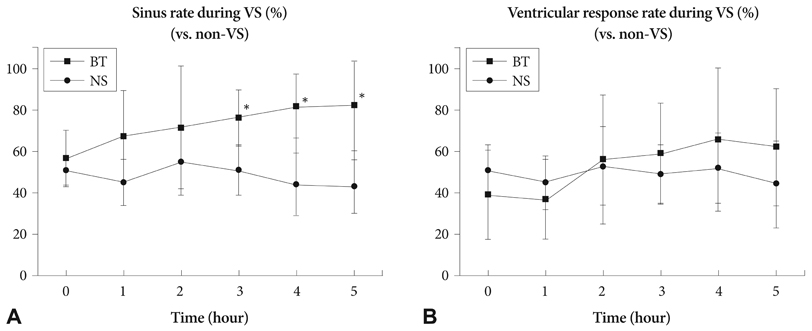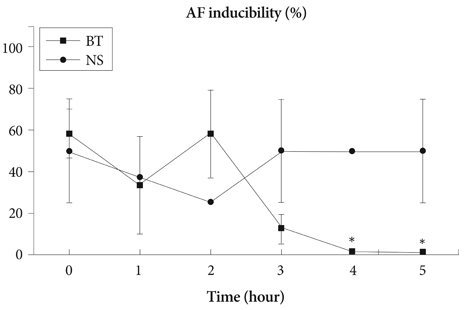Korean Circ J.
2010 Aug;40(8):387-390. 10.4070/kcj.2010.40.8.387.
Short-Term Autonomic Denervation of the Atria Using Botulinum Toxin
- Affiliations
-
- 1Department of Internal Medicine, Seoul National University College of Medicine, Seoul, Korea. seil@snu.ac.kr
- KMID: 2145530
- DOI: http://doi.org/10.4070/kcj.2010.40.8.387
Abstract
- BACKGROUND AND OBJECTIVES
Major epicardial fat pads contain cardiac ganglionated plexi (GP) of the autonomic nervous system. Autonomic denervation may improve the success rate of atrial fibrillation (AF) ablation. This study was designed to elucidate the acute effects of blocking the right atrium-pulmonary vein (RA-PV) and left atrium-inferior vena cava (LA-IVC) fat pads on the electrophysiologic characteristics of the atrium and AF inducibility with a botulinum toxin injection. Materials and Methods: Eight mongrel dogs were studied. The RA-PV and LA-IVC fat pads were exposed through a median thoracotomy. Botulinum toxin (BT, 50 U to each fat pad, n=6) or normal saline (NS, n=2) was injected in the entire area of two fat pads. The study protocol was applied before injection and repeated at 1, 2, 3, 4, and 5 hours thereafter. The sinus rate, ventricular rate during rapid atrial pacing with a cycle length of 50 ms, and AF inducibility were measured with and without vagal stimulation (VS). Bilateral cervical VS was applied (20 Hz, 0.2 ms, 5.6+/-2.0 V). AF inducibility was evaluated with burst pacing with 200 impulses at a 50-ms cycle length.
RESULTS
VS effects on the sinus node and AF inducibility were eliminated a few hours after injection of BT; these changes were not observed after injection of NS.
CONCLUSION
Short-term autonomic denervation of the atria was achieved by blocking the major epicardial GP with BT.
Keyword
MeSH Terms
Figure
Reference
-
1. Ardell JL, Randall WC, Cannon WJ, Schmacht DC, Tasdemiroglu E. Differential sympathetic regulation of automatic, conductile, and contractile tissue in dog heart. Am J Physiol. 1988. 255:H1050–H1059.2. Chiou CW, Eble JN, Zipes DP. Efferent vagal innervation of the canine atria and sinus and atrioventricular nodes: the third fat pad. Circulation. 1997. 95:2573–2584.3. Armour JA, Murphy DA, Yuan BX, Macdonald S, Hopkins DA. Gross and microscopic anatomy of the human intrinsic cardiac nervous system. Anat Rec. 1997. 247:289–298.4. Pauza DH, Skripka V, Pauziene N, Stropus R. Morphology, distribution, and variability of the epicardiac neural ganglionated subplexuses in the human heart. Anat Rec. 2000. 259:353–382.5. Yoo KD, Youn HJ, Chung WS, et al. The effects of autonomic denervation on ventricular tachyarrhythmia in the ischemia and the reperfusion of canine heart. Korean Circ J. 2001. 31:567–575.6. Schauerte P, Scherlag BJ, Pitha J, et al. Catheter ablation of cardiac autonomic nerves for prevention of vagal atrial fibrillation. Circulation. 2000. 102:2774–2780.7. Pappone C, Santinelli V, Manguso F, et al. Pulmonary vein denervation enhances long-term benefit after circumferential ablation for paroxysmal atrial fibrillation. Circulation. 2004. 109:327–334.8. Lemery R, Birnie D, Tang AS, Green M, Gollob M. Feasibility study of endocardial mapping of ganglionated plexuses during catheter ablation of atrial fibrillation. Heart Rhythm. 2006. 3:387–396.9. Edgerton JR, Jackman WM, Mack MJ. Minimally invasive pulmonary vein isolation and partial autonomic denervation for surgical treatment of atrial fibrillation. J Interv Card Electrophysiol. 2007. 20:89–93.10. Montecucco C, Schiavo G, Tugnoli V, de Grandis D. Botulinum neurotoxins: mechanism of action and therapeutic applications. Mol Med Today. 1996. 2:418–424.11. Tsuboi M, Furukawa Y, Kurogouchi F, Nakajima K, Hirose M, Chiba S. Botulinum neurotoxin A blocks cholinergic ganglionic neurotransmission in the dog heart. Jpn J Pharmacol. 2002. 89:249–254.12. Oh S, Zhang Y, Bibevski S, Marrouche NF, Natale A, Mazgalev TN. Vagal denervation and atrial fibrillation inducibility: epicardial fat pad ablation does not have long-term effects. Heart Rhythm. 2006. 3:701–708.13. Scanavacca M, Pisani CF, Hachul D, et al. Selective atrial vagal denervation guided by evoked vagal reflex to treat patients with paroxysmal atrial fibrillation. Circulation. 2006. 114:876–885.14. Katritsis D, Giazitzoglou E, Sougiannis D, Goumas N, Paxinos G, Camm AJ. Anatomic approach for ganglionic plexi ablation in patients with paroxysmal atrial fibrillation. Am J Cardiol. 2008. 102:330–334.
- Full Text Links
- Actions
-
Cited
- CITED
-
- Close
- Share
- Similar articles
-
- Selective Peripheral Denervation for the Treatment of Spasmodic Torticollis
- Application of Botulinum Toxin in Pain Management
- Urologic Applications of Botulium Toxin
- Temporary Accommodation Difficulties after Botulinum Toxin Type B Injection for the Treatment of Hyperhidrosis
- Botulinum toxin type A therapy in cluster headache: A case report



